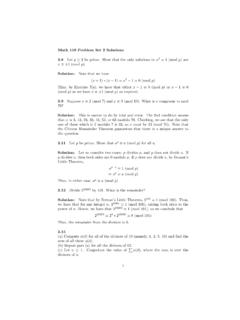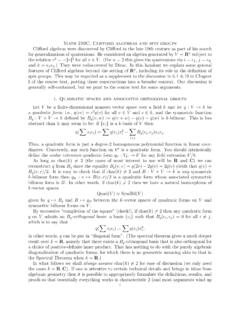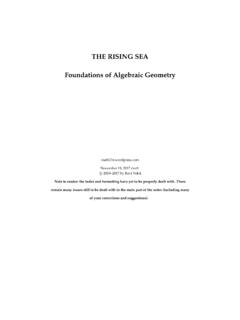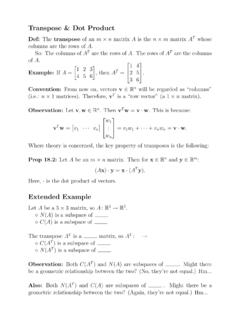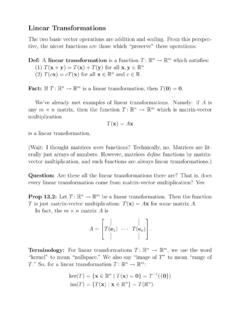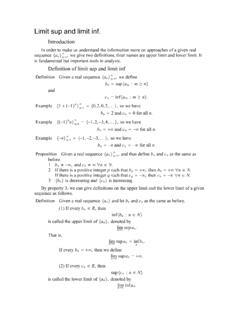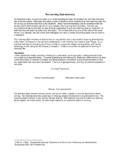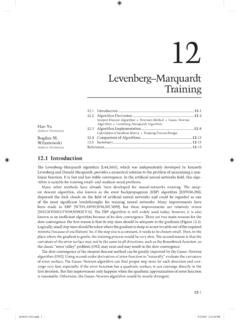Transcription of Laplace Transform: Examples
1 Laplace Transform: ExamplesDef:Given a functionf(t) defined fort >0. ItsLaplace transformis thefunction, denotedF(s) =L{f}(s), defined by:F(s) =L{f}(s) = 0e stf(t)dt.(Issue:The Laplace transform is an improper integral. So, does it always exist? : Is thefunctionF(s) always finite?Answer:This is a little subtle. We ll discuss this next time.)Fact (Linearity):The Laplace transform islinear:L{c1f1(t) +c2f2(t)}=c1L{f1(t)}+c2L{f2(t)}.Example 1:L{1}=1sExample 2:L{eat}=1s aExample 3:L{sin(at)}=as2+a2 Example 4:L{cos(at)}=ss2+a2 Example 5:L{tn}=n!sn+1 Useful Fact:Euler s Formula says thateit= cost+isinte it= cost isintTherefore,cost=12(eit+e it),sint=12i(eit e it). Laplace Transform: Key PropertiesRecall:Given a functionf(t) defined fort >0. ItsLaplace transformisthe function, denotedF(s) =L{f}(s), defined by:F(s) =L{f}(s) = 0e stf(t) :In the following, letF(s) =L{f(t)}.Fact A:We haveL{eatf(t)}=F(s a).Fact B (Magic):Derivatives int Multiplication bys(well, almost).L{f (t)}=(s1) (F(s) f(0))=sF(s) f(0)L{f (t)}= s2s1 F(s) f(0) f (0) =s2F(s) sf(0) f (0)L{f(n)(t)}= snsn F(s) f(0) f(n 2)(0) f(n 1)(0) =snF(s) sn 1f(0) sf(n 2)(0) f(n 1)(0).
2 Fact C (Magic):Multiplication byt Derivatives ins(almost).L{tf(t)}= F (s)L{tnf(t)}= ( 1)nF(n)(s). Laplace Transform: ExistenceRecall:Given a functionf(t) defined fort >0. ItsLaplace transformisthe function defined by:F(s) =L{f}(s) = 0e stf(t) :The Laplace transform is an improper integral. So, does it alwaysexist? : Is the functionF(s) always finite?Def:A functionf(t) is ofexponential orderif there is a thresholdM 0and constantsK >0,a Rsuch that|f(t)| Keat,whent : There is a thresholdM 0 and a constanta Rsuch thatthe functionf(t)eatisboundedwhent M(meaning that f(t)eat K).Theorem:Letf(t) be a function that is:(1) continuous;(2) of exponential order (with exponenta).Then:(a)F(s) =L{f(t)}(s) exists for alls > a; and(b) lims F(s) = :The functionf(t) = exp(t2) is not of exponential :Iff(t) is not continuous, or not of exponential order, then theLaplace transform may or may not Laplace Transform: ExistenceWant:A notion of inverse Laplace transform.
3 That is, we would like tosay that ifF(s) =L{f(t)}, thenf(t) =L 1{F(s)}.Issue:How do we know thatLeven has an inverseL 1? Remember, not alloperations have see the problem: imagine that there are different functionsf(t) andg(t) which have the same Laplace transformH(s) =L{f}=L{g}. ThenL 1{H(s)}would make no sense: after all, shouldL 1{H}bef(t) org(t)?Fortunately, this bad scenario can never happen:Theorem:Letf(t),g(t) be continuous functions on [0, ) of exponentialorder. IfL{f}=L{g}, thenf(t) =g(t) for allt [0, ).Def:Letf(t) be continuous on [0, ) and of exponential callf(t) theinverse Laplace transformofF(s) =L{f(t)}. Wewritef=L 1{F}.Fact (Linearity):The inverse Laplace transform islinear:L 1{c1F1(s) +c2F2(s)}=c1L 1{F1(s)}+c2L 1{F2(s)}.Inverse Laplace Transform: ExamplesExample 1:L 1{1s a}=eatExample 2:L 1{1(s a)n}=eattn 1(n 1)!Example 3:L 1{ss2+b2}= cosbtExample 4:L 1{1s2+b2}=1bsinbtFact A:We haveL{eatf(t)}=F(s a).Therefore:L 1{F(s a)}=eatL 1{F(s)}.Partial FractionsSetup:Given a rational functionR(x) =p(x)q(x).]]]
4 Saying thatRis rational means that bothpandqare by factoring the denominatorq(x) overR. (The phrase overR means, , thatx3+ 4xfactors asx(x2+ 4). That is, we do not allow com-plex numbers. Factoring intox(x+ 2i)(x 2i) would be factoring overC. )Case 1:q(x) has linear distinct factors, meaning that we can expressq(x) =(x a1) (x an). In this case, we writep(x)q(x)=A1x a1+ +Anx 2:q(x) has linear factors, where some are repeated. Corresponding tothis factor like (x a)p, we writeA1x a+A2(x a)2+ +Ap(x a) 3:q(x) has a quadratic factor, not repeated. Corresponding to a factorlike (x ( +i ))(x ( i )) = (x )2+ 2, we writeA(x ) +B (x )2+ 4:q(x) has repeated quadratic factors. Corresponding to a factor like((x )2+ 2)n, we writeA1(x ) +B1 (x )2+ 2+A2(x ) +B2 ((x )2+ 2)2+ +An(x ) +Bn ((x )2+ 2) :Here is a partial fraction decomposition:7x3+ 2(x 3)2(x2+ 25)2=Ax 3+B(x 3)2+Cx+ 5Dx2+ 25+Ex+ 5F(x2+ 25) : Intro to Power SeriesApower seriesis a series of the form n=0an(x x0)n=a0+a1(x x0) +a2(x x0)2+ It can be thought of as an infinite polynomial.
5 The numberx0is called power series may converge for some values ofx, but diverge for othervalues ofx. A power series willalwaysconverge at its centerx=x0(do yousee why?).Question:Given a power series, for what values ofxdoes it converge, andfor what values ofxdoes it diverge?Theorem:Given a power series an(x x0)n. Then either:(i) The power series converges only atx=x0. (CaseR= 0)(ii) The power series converges for allx R. (CaseR= + )(iii) The power series converges on an interval|x x0|< R, and divergesif|x x0|> numberRis called theradius of :This theorem says nothing about the convergence /divergence at theendpoints of the interval. Those have to be checked the Interval of convergence :(1) Determine the centerx0.(2) Determine the radius of convergenceR. Use the Ratio Test to do this.(3) Check convergence /divergence at the : Power Series are FunctionsGiven a power series an(x x0)n, we can think of it as a function ofx:f(x) = n=0an(x x0) off(x): The set of allx-values for which the series converges.
6 Thatis, the domain is exactly the interval of every power series (withR >0) is a function, not all functionsarise in this way. : Not all functions are equal to a convergent powerseries! Those functions which are have a special name:Def:A functionf(x) isanalyticatx=x0if it is equal to a power seriesf(x) = n=0an(x x0)nthat haspositiveradius of convergenceR > functions are the best-behaved functions in all of calculus. Forexample, every analytic function is infinitely-differentiable:Theorem:Letf(x ) be analytic atx0, sayf(x) = n=0an(x x0)nwith radiusof convergenceR >0. Then:(a)fis infinitely-differentiable on the interval (x0 R,x0+R).(b) The derivative offis:f (x) = n=1nan(x x0)n 1( )(c) The indefinite integral offis: f(x)dx=C+ n=0an(x x0)n+1n+ 1( )(d) The radii of convergence of ( ) and ( ) are :Again, this theorem says nothing about convergence /divergence atthe endpoints. Those have to be checked : Taylor SeriesRecall that apower seriesis any series of the form n=0an(x x0)n=a0+a1(x x0) +a2(x x0)2+ Def:Letf(x) be infinitely-differentiable on an interval|x x0|< series offatx=x0is the power series n=0f(n)(x0)n!
7 (x x0)n=f(x0) +f (x0)1!(x x0) +f (x0)2!(x x0)2+ So, by definition: every Taylor series is a power , every power series withR >0 is a Taylor series:Theorem:Iff(x) = an(x x0)nis a power series with radius of conver-genceR >0, thenan=f(n)(x0)n!.(So: The given power series an(x x0)nis exactly the Taylor series off(x).)Corollary:Iff(x) is analytic atx0, thenf(x) = n=0f(n)(x0)n!(x x0) : Iffis analytic atx=x0, then the Taylor series offdoes converge infinitely-differentiable atx0butnotanalytic those functions, the Taylor series atx0will only equalf(x) atx=x0 even if the Taylor series converges on an interval (x0 R,x0+R)!Classic Scary Example:The functionf(x) ={exp( 1x2) ifx6= 00ifx= on all ofR. Its derivatives atx= 0 aref(n)(0) = 0for eachn= 0,1,2,.. Therefore, its Taylor series atx= 0 is0 +01!x+02!x2+ which converges on all ofRto the functiong(x) = : Our functionf(x) (which is defined on all ofR) is only equal to itsTaylor series (which is also defined on all ofR) atx= 0.}
8 Weird!Review: Examples of Taylor SeriesMany of the functions we care about are analytic, meaning that they areequal to a power series. For example:ex= n=0xnn!= 1 +x1!+x22!+x33!+ sinx= n=0( 1)nx2n+1(2n+ 1)!=x x33!+x55! x77!+ cosx= n=0( 1)nx2n(2n)!= 1 x22!+x44! x66!+ It s also good to know aboutsinhx= n=0x2n+1(2n+ 1)!=x+x33!+x55!+x77!+ coshx= n=0x2n(2n)!= 1 +x22!+x44!+x66!+ Again: Iff(x) is analytic, meaning that it is equal to a power series, thenthat power series is the Taylor series off(x).Review: Taylor PolynomialsDef:Thenth-degree Taylor polynomial off(x) is the polynomialTn(x) =f(x0) +f (x0)1!(x x0) + +f(n)(x0)n!(x x0) Point of Taylor Series:The Taylor polynomialsTn(x) are the bestpolynomial approximations tof(x) near the centerx= : The first Taylor polynomialT1(x) =f(x0) +f (x0)(x x0)is the best linear approximation nearx=x0. After all,T1(x) is exactly thetangent line tof(x) atx= : The second Taylor polynomialT2(x) =f(x0) +f (x0)(x x0) +f (x0)2!
9 (x x0)2is the tangent parabola atx=x0. Et Solutions to ODEs: Ordinary PointsGoal:Given a 2nd-order linear ODE (with non-constant coefficients)y +p(x)y +q(x)y= usually cannot solve fory(x) : Maybe we can expressy(x) as a power series:y(x) = n=0an(x x0) we can do this, then the partial sums ( : the Taylor polynomials) arepolynomial approximationstoy(x).Def:Given a 2nd-order linear ODEy +p(x)y +q(x)y= pointx0is aordinary pointif bothp(x),q(x) are analytic pointx0is asingular :Given a 2nd-order linear ODEy +p(x)y +q(x)y= thatx0is an ordinary the general solution may be written as a power seriesy= n=0an(x x0)n=a0y1(x) +a1y2(x),wherea0,a1are arbitrary constants, andy1(x),y2(x) are power-series solu-tions (and hence analytic atx0). Moreover,{y1(x),y2(x)}is a fundamentalset of : the radii of convergence for the series solutions ofy1(x),y2(x) are atleast the minimum of the radii of convergence of the series forp(x) andq(x).Fourier Series: IntroRecall:Apower seriesis an infinite polynomial.
10 Given a functionf(x), theTaylor series off(x) is a power series wherethe coefficients are determined by some formula (an=f(n)(x0)n!).Often, the Taylor series off(x) does converge tof(x). So, Taylor serieslet us approximatef(x) by a sequence of :Atrigonometric seriesis an infinite trig polynomial. Given a functionf(x), theFourier series off(x) is a trigonometric serieswhere the coefficients are determined by some formula (below).Often, the Fourier series off(x) does converge tof(x). So, Fourier serieslet us approximatef(x) by a sequence of waves. Def:Atrigonometric seriesis an infinite series of the forma02+ n=1(ancos(n Lx)+bnsin(n Lx)).Given a functionf(x), itsFourier seriesis the trigonometric series whosecoefficients are given by:an=1L L Lf(x) cos(n Lx)dx(A)bn=1L L Lf(x) sin(n Lx)dx.(B)So, every Fourier series is a trigonometric series. Conversely, every conver-gent trigonometric series is a Fourier series:Fact:Iff(x) =a02+ n=1(ancos(n Lx)+bnsin(n Lx))is a trigonometricseries which converges, then its coefficientsan,bnare given by (A)-(B) convergence Theorem:Supposef(x) is periodic of period also thatf(x) andf (x) are piecewise-continuous on [ L,L).]


